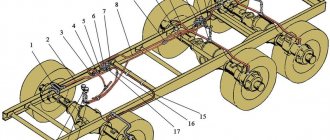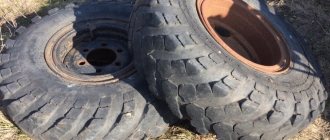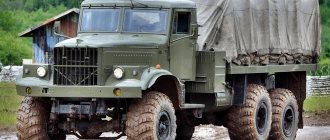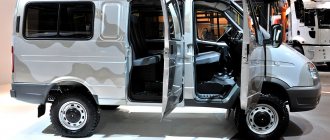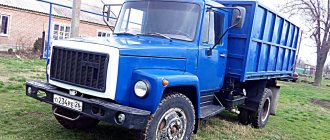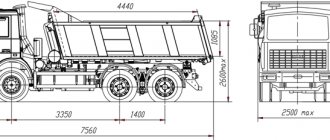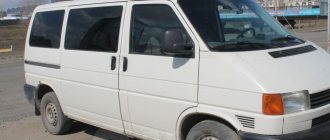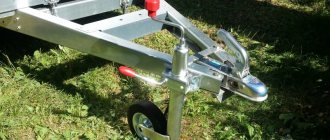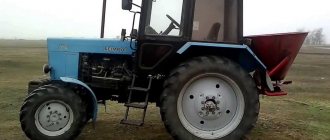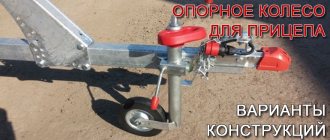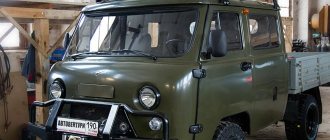The Likhachev plant is one of the oldest automobile manufacturing enterprises in Russia. ZIL brand trucks gained great popularity and were produced in huge, mass quantities.
This article will describe the main features of tires for ZIL vehicles, provide step-by-step instructions for disassembling wheels on a ZIL-131, provide a description of the ZIL-132 all-terrain vehicle with arched wheels, and also provide detailed characteristics of wheels for the ZIL-130.
Wheel for ZIL
What size tires for gas 53?
The GAZ 53 car is equipped from the factory with 20-inch wheels with tires of 7.50/R20 or 8.25/R20 (240-508R).
What tire pressure should be on gas 53?
The tire pressure of a GAZ 53, a dump truck with radial wheels, must correspond to the following indicators: for the front wheels the required air pressure is 390 kPa, for the rear wheels 620 kPa.
What wheels are used on gas 66?
On the 66 and 3308, as on the Tiger, the tire size is 12.00 R18, there is also the K 58 13.00 R18 tire, a rather rare thing, the main sizes of truck tires are in sizes R20 - 21 - 22.5, including off-road.
How much does a 53 gas tire weigh?
| Tire brand | Weight, kg) | For which cars |
| U-2 (8.25R20) | 36,55 | GAZ-53, GAZ-53A, PAZ-3205 |
| I-397 (8.25R20) | 36,55 | |
| KAMA-RAIDE (9.00R20) | 43,57 | KamAZ, KAZ, ZIL |
| I-N142BM (9.00R20) | 44,50 |
What is the tire size for ZIL 130?
Wheels on the ZIL 130 allow the installation of tires of size 9.00R20 (260R508) and 10.00R20 (280R508). Tires of this size are very common and are installed on many other cars, for example, on the ZIL 133GYA. A tire of size 10.00R20 (280R508) is installed on the ZIL 4331 wheel rim.
What is the tire pressure for gas 53 dump truck?
The tire pressure of a GAZ 53, a dump truck with radial wheels, must correspond to the following indicators: for the front wheels, the required air pressure is 390 kPa; for the rear - 620 kPa.
How many atmospheres are there in a lawn wheel?
Recommended tire pressure values should be indicated on a plate on the car body. According to the online calculator for Lawn Next, on 20 tires the air pressure should be 6.1. for the front wheels, 6.9 - for the rear.
What tire pressure should be on gas 66?
Internal pressure with maximum load – 340 kgf; Static radius – 505 mm; Applicability - on trucks GAZ - 66, ZIL - 157; The nominal air pressure in tires is 2.8 kgf/cm2.
ZIL-132 6x6 with arched tires
ZIL-132 is a legendary Soviet all-terrain vehicle with a 6x6 wheel arrangement. The car is equipped with three equidistant axles, which are located at a distance of 2.5 meters from each other, and wide arched tires so that the heavy all-terrain vehicle (the vehicle weighs almost 10 tons) does not fall into the ground. Thus, the 132nd all-terrain vehicle, created in the early 60s of the 20th century, was opposed to tracked vehicles, since before its creation only tracked all-terrain vehicles had high maneuverability.
The volumetric tires also provided a soft ride, since the suspension, which is usually responsible for this function, was absent: the car was built with a rigid mount of the discs to the frame without an elastic element.
The ZIL-132 was equipped with eight-ply arched tires with an “oblique dissected Christmas tree” tread pattern. The front and rear wheels are swivel and are equipped with hydraulic boosters for these purposes.
The air pressure in the tires was adjusted depending on the condition of the road surface. To do this, the all-terrain vehicle was equipped with a central system for regulating air pressure in the tires. The minimum pressure was used when moving in particularly difficult off-road conditions. It was possible to change the tire pressure on the left and right side independently of each other.
Useful tips
For disassembling and assembling wheels, the tool kit supplied with the vehicle includes two mounting blades: one with a flat end and one with a curved grip. The latter simultaneously serves as a jack lever.
According to the operating instructions and repair manual for the 131st car, in order to preserve the tire beads and facilitate all operations, the removal of a tire from a wheel can only be carried out at a specialized stand for tire removal and only in exceptional cases - manually.
Dismantling the wheels, due to the size of the tires for the ZIL 131, is a very labor-intensive task. It will be extremely difficult to cope with this situation alone. In addition, many old wheels sit very tightly on the rim. To disassemble them manually, a sledgehammer and angles are used to help.
Important!
It is strictly forbidden to try to remove the tire bead by hitting the lock ring with a sledgehammer, since during these manipulations the impact force is transferred by the ring not to the tire, but to the lock groove of the rim, which will only cause damage to the ring.
Characteristics
A huge selection of additional equipment was offered for ZIL trucks, which made the vehicle universal for all areas of operation. The machine could be used to transport goods, and the version with a crane could be used for construction and utility purposes.
The truck was equipped with a 6.0 liter V-shaped engine with 8 cylinders and a two-chamber carburetor. Output power of 150 hp. it was enough for a load capacity of 6 tons, and it allowed it to confidently perform the functions of a medium-tonnage truck.
Further modifications of the truck were produced with a modified version of the ZIL-130 engine. Most improvements consisted of adapting the motor to various conditions (faster acceleration, greater load capacity, etc.).
Modified version of the ZIL-130 engine
Replacement
To replace standard ZIL wheels, the following options, which have proven themselves only on the positive side, are ideal:
- Omskshina N142B-1 is an ideal ZIL-130 tire. All-season tires that meet all modern requirements for reliability in cargo transportation. They performed well on trucks and are therefore one of the most popular on the market.
- Kama 218 – tires for light trucks (ZIL Bychok). Excellent directional stability, low price and excellent handling - what else is required from good tires?
- ForwardTraction is one of the best tires for ZIL-4331. Provides excellent grip on the road surface and high directional stability and gives the car excellent driving characteristics.
- M-93 is a tire that has proven itself only from the best side. The dimensions are ideal for the ZIL-131, and the driving characteristics fully meet the requirements of this vehicle. The unique tread pattern gives the tire high cross-country ability and makes the rubber one of the best on the market.
- ALTAISHINA ID-304 is another tire for 131. Low cost and excellent characteristics make this tire a worthy competitor among analogues. Despite the fact that the tread pattern is universal, it gives the car high directional stability and resistance to aquaplaning.
Selection
What tire characteristics must be observed when choosing tires for trucks? To choose the right tires, you must follow the recommended size of ZIL tires, and during operation, strictly monitor the pressure indicator in ZIL tires. By following these two rules, the tires will last a long time without requiring replacement.
Standard size
The size must be selected in accordance with the selected configuration and body. For certain conditions, the factory has selected special wheel sizes that ensure travel in certain conditions (off-road, etc.). You can find information in the vehicle's operating instructions.
User manual
For the most common models, the standard size is:
- ZIL-130 (4x2) – 9.00-20 (260-508);
- tire size ZIL-131 (6x6) – 12.00R20 (320R508);
- ZIL Bychok 5301 (4x2) – 225/75R16;
- ZIL-157 (6x6) – 12.00R18 (320R457);
- ZIL-4331 (4x2) – 9.00R20 (260R508).
Tire ZIL Bychok 5301
It is necessary to comply with the specified standard sizes so that the center of gravity does not shift and the tires do not wear out quickly.
Pressure
Another of the main indicators that must be observed during operation is pressure. The performance and softness of the suspension, tire service life and a number of other parameters depend on the pressure characteristics. It must be remembered that when the tires are fully loaded, it is necessary to inflate or deflate so that the machine does not sag under the load and “chew” the tire.
For popular models, the pressure should be:
- ZIL-130 – 4.5 front and 6.0 rear wheels;
- ZIL-131 – 3.0 for the front, 5.8 rear tires;
- ZIL Bychok 5301 – 4 atmospheres;
- ZIL-4331 – 6 atmospheres for all wheels;
Due to the age of the ZIL-157, the pressure is selected individually.
Important: the values are indicated for cars without load, operating in the summer!
Car tires
Tires absorb shocks from road unevenness, significantly unloading the suspension parts.
Modern cars are equipped with pneumatic tires, which can be tubed or tubeless.
On GAZ-53A, GAZ-51A and ZIL-130 vehicles, a tube tire is used, consisting of a tire, a tube with a valve and a rim tape that protects the tube from abrasion by the wheel rim and pinching by the edges of the tire.
Tire section
Tire cut:
1 — bead core (wire ring); 2 - sidewall; 3 - frame; 4 - cushion layer; 5 — protector; 6 - board.
The tire consists of a frame 3, a cushion layer 4, a tread 5, sidewalls 2 and beads 6.
The frame is made of several layers of rubberized fabric
- cord and firmly attached to the rigid beads that secure the tire to the wheel rim. The sides are embedded with cores (rings) made of steel wire wrapped in tape. The rings prevent the beads from stretching and prevent the tire from slipping off the wheel.
The cushion layer of rubber lying between the tread and the frame protects the latter from damage. The tread pattern depends on the purpose of the tire.
Camera
- a closed rubber sleeve into which air is pumped through a valve built into it - a valve that allows air only into the chamber.
Valves
a - metal; b - rubber-metal;
1 - body; 2 — cap-key; 3 - nipple; 4 - valve; 5 - spring; 6 - sealing washer; 7 - camera; 8 — valve washer; 9 - nut; 10 - rubber body.
Main valve parts
- a rubber-metal or metal body, a spool consisting of a nipple and a valve with a spring, and a cap. When the tire is inflated, the valve opens from the air pressure, overcoming the elastic force of the spring, and when the air supply stops, the spring closes the valve and, therefore, the release of air from the chamber becomes impossible.
To make it easier to inflate air with a tire pump, the tip of its hose is equipped with a rod, which, when connecting the hose to the valve, forcibly opens the valve. When the hose tip is unscrewed from the valve, the valve is released.
Tire sizes
D—outer diameter; d—inner diameter; B and H are the width and height of the profile.
Their dimensions in inches or millimeters are marked on the side surface of the tire and tube. The first number indicates the width of the profile B, the second - the diameter d of the wheel rim.
Tire sizes and air pressure are shown in the table.
| Automobile model | Tire designation 1 | Air pressure in tires, kn/m 2 (kgf/cm 2) | |
| front wheels | rear wheels | ||
| GAZ-53A | 240 — 508 (8,25 — 20) | 280(2,8) | 430(4,3) |
| GAZ-51A | 220 — 508 (7,50 — 20) | 300(3,0) | 350(3,5) |
| ZIL-130 | 260 — 508 (9,0 — 20) | 350(3,5) | 500(5,0) |
| "Moskvich-412" | 155 — 330 (6,00 — 13) | 170(1,7) | 170(1,7) |
| 1 The designation in inches is given in parentheses. | |||
For a GAZ-53A car, the tire is mounted on a disk with a wide rim, which is held on it by one bead and a locking ring.
On a GAZ-51A car, the tire is held on the rim by two rings:
side and lock.
Wheel disc with a flat rim of a GAZ-51A car
Wheel disc with a flat rim of the GAZ-51A car:
1 - rim; 2 — disk; 3 — removable side ring; 4 - locking ring.
Tube or tubeless tires are installed on the one-piece deep rim of the wheel of the Moskvich-412 car. A tubeless tire does not have a tube, and air is retained in it due to the tight connection between the tire and the beads of the wheel rim. The valve is installed directly in the rim.
Deep rim wheel rim and tire
Wheel rim with deep rim and tire of the Moskvich-412 car:
1 - camera; 2 - valve; 3 — tire; 4 - rim; 5 - disk.
Tire pressure is checked with a tire pressure gauge.
Tire faults
Their main malfunctions:
wear, punctures and cuts, delamination and rupture of the frame. Most often, tires wear out quickly due to non-compliance with air pressure standards in them. If the pressure increases, the contact surface of the tire with the road is reduced, wear of the central part of the tread increases, the tire loses elasticity, the cord threads are overstressed and break. At reduced pressure, the tire frame becomes more deformed and quickly collapses. Damaged tires are repaired or replaced with new ones.
